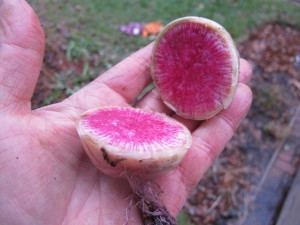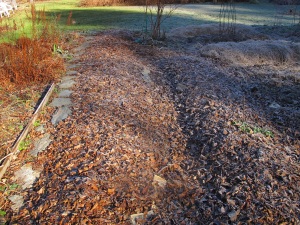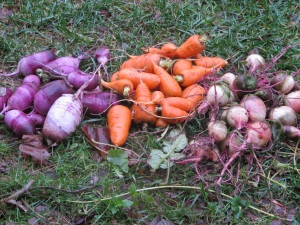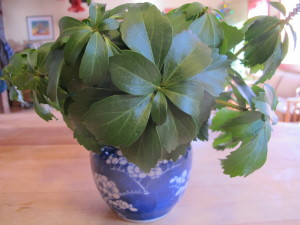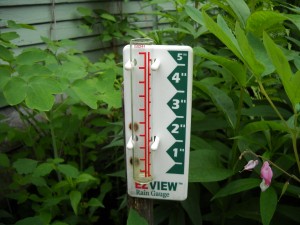Working in the Rain
After a cold snap recently we had 3 days of cold rain. By the second day, with no relief in sight, I went out to my garden and dug up the last of my root crops – carrots, watermelon radishes and purple daikon radishes. I figured that I’d better get them out of the ground while the getting was good. I came back wet and muddy, but feeling much more cheerful than before I went to the garden.
By day three, I was positively squirrely. I needed to do something outdoors. So I got dressed for an extended time in the garden: I layered on some Ibex brand wool long johns, two layers on top, and one on the bottom. Ibex makes its products from Merino wool, so they are not scratchy and seem to last forever. Then I put on rain pants and an LL Bean Gortex raincoat that keeps me dry and helps keep me warm. Rubber-palmed stretchy garden gloves protected my hands. Finally, I put on wool socks and my insulated Muck brand boots. I was ready.
I often warn gardeners not to walk on the garden soil when it is wet for fear of compacting it and ruining its structure. But I had some raised beds in the vegetable garden where I had harvested root crops – but not the late-season weeds that were there. I figured that so long as I worked carefully and never stepped off the walkways that I’d be fine.
I used a garden fork to loosen the soil near tap-rooted dandelions, then carefully tugged them out. How had so many escaped my notice? Well, I guess it was the “late-season weed blindness” that many of us suffer from. It is often spring before I notice certain weeds – because they’re blooming.
I did know, however, that I had a fair amount of chickweed (Stellaria media) in my garden, as that weed grows whenever the ground is not frozen – including early and late in the growing year. I once interviewed author David Mas Masumoto (author of Epitaph for a Peach) who told me that chickweed is a ”good weed”. It’s good because it blooms early and beneficial insects like ladybugs depend on its nectar for food before the aphids turn up as lunch.
Chickweed is a low-growing annual that has very small pointed leaves, each only a quarter to half an inch in length. The flowers – and mine are present now – are small and white; on cold rainy days, the flowers are just like me – buttoned up tightly. With a hand lense or field scope you can see that it has fine hairs on only one side of the stem in a single band. It pulls easily, and best of all, it is edible in salads! I think it tastes like mache or miner’s lettuce – okay to mix in, but not as a prime salad ingredient.
After about 15 minutes my hands were cold, so I went in and found my Ibex glove liners, which solved the problem. Wool is warm, even if wet. And I put on another layer of socks, and that kept my feet warm, too.
I buy composted cow manure by the truckload, and still have a supply left from last spring’s delivery. So after weeding out two small beds I brought down a couple of wheelbarrows of compost, spread it on top of the beds and gently stirred it into the top few inches with a long-handled potato fork.
I grow my vegetables in beds that are mounded up, or occasionally boxed in with planks. In either case, plants take out soil ingredients, and every time you pull a weed (or carrot) some soil goes with the roots, no matter how careful you are. So beds need new soil or compost added each year to keep their size.
Once the beds were all prepared for spring, I found some lawn that had been covered with late-falling leaves – oaks. Oaks are among the last to shed their leaves, and so had escaped earlier raking. I gathered them up and used them to cover the beds.
During this period of cold, cloudy, dark, damp, dismal miserable weather I collected some greenery to use in vases this winter. Pachysandra is a common shade groundcover that will look good all winter in a vase of water. In fact, it will even set out roots into the water. Just keep the leaves out of the water, and change the water from time to time. It doesn’t need to be on a sunny window, and can complement any flower arrangement you buy at the store. So I picked some and brought it in.
What else did I do during the week of wet weather? I did a little pruning – nothing major, no ladders, I just tuned up a few shrubs and a small tree. I have a common ninebark, one called ‘Diablo’, which looks as neat as an unmade bed right now. But I resisted the urge to prune it as I know it blooms early in the summer, and pruning it now would remove the flower buds. Lilacs, forsythia, and rhododendrons: all these and more have their buds ready for spring. Some flowers I can sacrifice, others not.
So if you get tired of being indoors, go ahead, dress up warmly and get out there – even if it’s raining. It’s very restorative.
Henry can be reached at P.O. Box 364, Cornish Flat, NH 03746 or by email at henry.homeyer@comcast.net. Please include a SASE if you wish a reply to questions by regular mail.
Gardening in the Rain
I’ve always preferred sunny days, both as a boy and now, as a quasi-geezer. I remember reciting this ditty as a small boy, “Rain, rain, go away, come back some other day!” And it did, eventually – but usually not as quickly as I wanted. Now as a gardener I appreciate the rain for what it does for my plants, but I still think to myself, after a few hours of rain, “Rain, rain, go away …”
If you don’t have a rain gauge, you should. It doesn’t have to be one of those fancy electronic ones that sends signals to you from outdoors. A simple $5 device that consists of a cylinder with marks on the side to show each quarter inch of rain is just fine. And, if you really want to be frugal, an empty cat food or tuna can will work. Most of our plants need an inch of rain – or water from your hose – each week.
Plants are generally the most susceptible to death by dehydration right after planting. Their roots have been disturbed and frequently delicate root tips have been broken off. A hot, dry day can wreak havoc on a newly planted seedling. If your plants are growing in potting mix, it is best to submerse the plants in a bucket of water before nestling them into their growing holes. Hold the plants under the water until they stop bubbling. It can be hard to saturate a large root ball by top watering.
Rainy days are much better than sunny days for transplanting. You can minimize shock by preparing the new hole before you dig up the plant so that it can go right to its new home. My grandfather liked to say that you should move enough soil with a transplant that “it will remember where it came from.” Modern soil scientists would probably agree, saying that the soil microbes you move with a plant are important to its future health. After moving a plant, create a ring of soil around your transplant to hold water. Then, using a watering can, gently fill the ring and let water seep in. Repeat several times.
I add two solutions to my watering can that help to minimize transplant shock. The first is called SUPERthrive. It comes in a little 4oz container but it only takes a quarter of a teaspoon of the solution for a gallon of water to treat plants against transplant shock. It contains vitamins and minerals; in my experience it reduces transplant shock and helps stressed plants (like those 6-packs of annuals I forgot to water on a hot day).
The other solution I use is a liquid fish and seaweed fertilizer. Neptune’s Harvest makes a very nice product, though there are plenty of others. The fish “juice” gives new plants nitrogen, phosphorous, potassium and trace minerals at a time when they need a quick burst of soluble fertilizer.
But back to those rainy days: if you don’t mind working a warm rain, go outside and weed. Weeds pull much more easily when the soil is wet. But avoid a lot of digging in wet soil. I like my CobraHead weeder (www.CobraHead.com), in part, because it is a low-impact tool. I can use its single tine to stir up the soil enough to plant a small lettuce plant or make a furrow for carrot seeds without making a big mess of the soil on a rainy day.
I never walk on beds when they are wet. Wet soil compacts easily, especially soils with a high clay content. Clay that is compacted and then allowed to dry out can be as hard as concrete. And don’t even think of rototilling wet soil. You can ruin the soil texture by doing so.
Most of us have plants in pots on the front stoop or on the deck. Be attentive to them when it rains. If they have drainage holes (as they should), they will collect water in their saucers below. Roots can rot if left sitting in water for days on end. So remove the plants from their saucers in a deluge, or shortly thereafter. If you notice that the runoff is brown, you are probably losing good nutrients. Pour that water in a bucket to use on a dry day to water your plants.
Want an indoor planting project on a rainy day? Get out your potting soil and a few leftover 6-packs from spring planting. Plant some lettuce seeds in those 6-packs for use in the garden once they get to be an inch or two tall. I find that starting lettuce in 6-packs and growing them on the deck is better than direct seeding in the garden – no weeds, and they are easier to monitor for water. I try to remember to plant lettuce every 2 weeks for a good supply all summer. And you can start fall broccoli by seed in mid-July- so mark your calendar today, and do so on a rainy day.
There are times in early summer when I get bone tired from doing so much gardening, day after day. I can’t seem to get it through my thick skull that I’m not a kid anymore. So a rainy day is a good thing. It usually forces me slow down a little. And my plants love them – in moderation.
Henry Homeyer is a life-long organic gardener, a UNH Extension Master Gardener, and a gardening coach. Contact him at henry.homeyer@comcast.net or P.O. Box 364, Cornish Flat, NH 03746.



